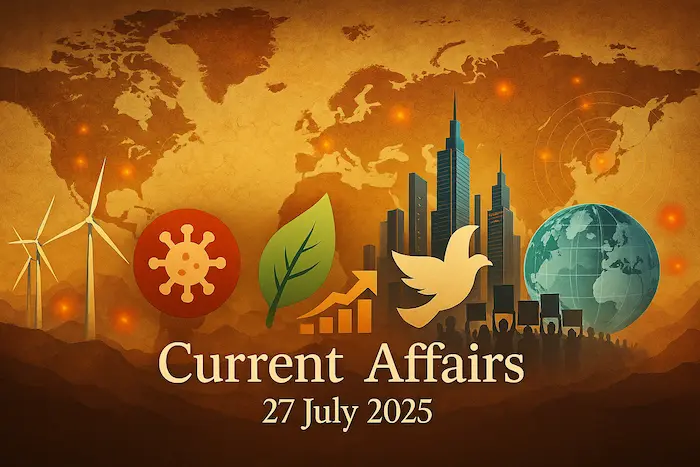1. Ramsar COP15 Opens in Zimbabwe -Environment
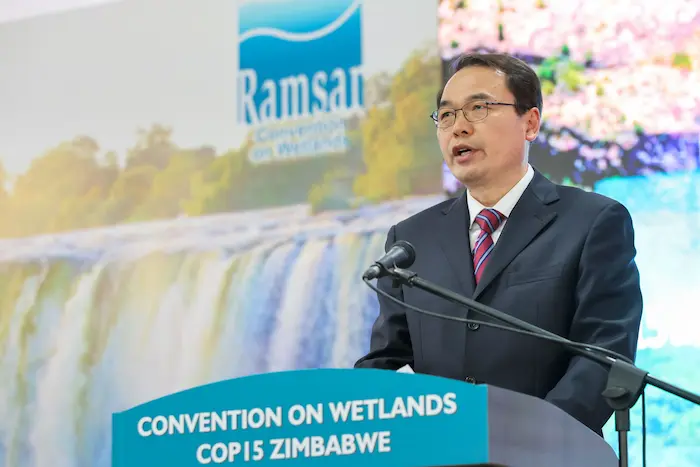
Why in News?
The 15th Meeting of the Conference of the Contracting Parties (COP15) to the Ramsar Convention on Wetlands has commenced in Victoria Falls, Zimbabwe. Delegates from 172 countries are participating to advance global wetland conservation.
Key Highlights
- Theme: “Protecting Wetlands for Our Common Future”
- Host Country: Zimbabwe (holds Ramsar COP Presidency for 3 years)
- Expected Outcome: Victoria Falls Declaration – a global framework for strengthening wetland protection and international cooperation.
About the Ramsar Convention
- Adopted: 2 February 1971 in Ramsar, Iran.
- Objective: Conservation and wise use of wetlands through local, national, and international action.
- India Joined: 1 February 1982
- First Indian Ramsar Site: Chilika Lake, Odisha (Designated in 1981)
- World Wetlands Day: Observed every year on 2 February
Key Functions of the Convention
- Designation of Wetlands of International Importance (Ramsar Sites)
- Promotes sustainable management and community participation
- Encourages scientific research, education, and international cooperation
- Tracks critically threatened sites under the Montreux Record
Ramsar Site Designation – Criteria (Any one of the 9 must apply):
- Unique or rare wetland type
- Habitat for endangered/vulnerable/endemic species
- Crucial for migratory waterbirds
- High biodiversity/ecological/hydrological value
- Supports ecosystem services (e.g., flood control, water purification)
- Provides cultural or spiritual value
- Supports sustainable livelihoods
- Has scientific or educational importance
- Requires international cooperation due to threats
India and Ramsar Convention – July 2025 Snapshot
- Total Ramsar Sites: 91
- Total Wetland Area under Protection: ~13.58 lakh hectares
- % of India’s Wetland Area Covered: ~10%
- Top States:
- Tamil Nadu: 20 sites
- Uttar Pradesh: 10 sites
- Fact: India has never chaired a Ramsar COP session.
Global Overview
- Total Member Countries: 171
- Most Sites:
- UK: 175
- Mexico: 142
- Largest Protected Wetland Area:
- Bolivia: ~1.48 lakh sq. km
Significance for India
- Wetlands in India play a critical role in biodiversity conservation, climate change mitigation, flood regulation, and livelihood support.
- Enhanced focus on international commitments may influence national wetland policies and future Ramsar nominations.
- Highlights the need for better monitoring, community participation, and wetland restoration in states like Himachal Pradesh, which has rich but vulnerable high-altitude wetland systems (e.g., Pong Dam Lake).
Exam Connect – Possible Questions
Prelims
- Which of the following is true regarding the Ramsar Convention?
A. It is legally binding under the United Nations framework.
B. India was a founding member of the convention.
C. Wetlands can be designated as Ramsar Sites only if they are in coastal areas.
D. The convention promotes the wise use of all wetlands.
Answer: D. The convention promotes the wise use of all wetlands. - Which Indian state has the highest number of Ramsar Sites as of July 2025?
A. Odisha
B. Uttar Pradesh
C. Tamil Nadu
D. Gujarat
Answer: C. Tamil Nadu - Montreux Record, often mentioned in environmental news, relates to:
A. Air pollution measurement
B. Forest cover data
C. Wetlands under threat
D. Coral reef bleaching
Answer: C. Wetlands under threat
Mains
- “Discuss the importance of wetlands in ecological and economic terms. How does the Ramsar Convention aid in their conservation, and what steps should India take to strengthen its wetland governance?”
- “Examine the role of international environmental treaties like the Ramsar Convention in shaping national conservation strategies. Critically evaluate India’s performance under the Ramsar framework.”
- “How do wetlands contribute to maintaining regional climatic and hydrological balance? Highlight their role with reference to the Himalayan region.”
2. Environmental Flow of the Ganga River – Environment

Why in News?
A recent high-level meeting chaired by the Union Minister of Jal Shakti focused on ensuring and enhancing the Environmental Flow (e-flow) of the Ganga River and its tributaries, amidst growing concern over the ecological degradation of India’s rivers.
What is Environmental Flow (E-Flow)?
Definition:
Environmental flow refers to the quantity, timing, and quality of water flows required to:
- Sustain freshwater and estuarine ecosystems
- Support biodiversity, especially aquatic species (e.g., fish)
- Provide for human livelihoods, particularly dependent communities
Why E-Flows Are Needed?
Indian rivers are facing serious challenges due to:
- Dam construction and river regulation
- Industrial & domestic pollution
- Encroachments on floodplains and riverbeds
These factors reduce the natural flow of rivers, impacting:
- Aquatic ecosystems
- Groundwater recharge
- Cultural and religious practices
- Livelihoods (e.g., fishing, agriculture)
Key Benefits of Maintaining E-Flows
- Preserves ecological integrity of rivers
- Supports migration and breeding of fish and aquatic life
- Helps dilute pollutants and maintain water quality
- Sustains wetlands, riparian zones, and deltaic ecosystems
- Ensures long-term water security and climate resilience
cientific and Ecological Basis
- E-flow studies assess species-specific flow needs (especially for key fish species)
- Models used include hydrological, ecological, and geomorphological parameters
- Focuses on seasonal variation (e.g., high flows in monsoon, low flows in lean season)
E-Flows and the Ganga River
- The Ganga is India’s most culturally and ecologically significant river.
- Environmental flows are essential for the success of the Namami Gange Programme.
- In 2018, the Central Water Commission (CWC) issued e-flow norms for the Ganga.
- However, implementation gaps and non-compliance continue to hinder river health.
Himachal Pradesh Context
- Rivers originating in HP (e.g., Sutlej, Beas) are increasingly regulated by hydropower projects.
- Similar e-flow principles are critical for Himalayan rivers to:
- Protect fragile aquatic ecosystems
- Sustain downstream communities
- Balance energy needs with ecological health
Exam Connect – Possible Questions
Prelims
- Which of the following best describes the concept of environmental flow (e-flow)?
A. Maximum discharge capacity of a river during floods
B. Minimum flow required to sustain aquatic ecosystems and human livelihoods
C. Flow needed for hydropower generation
D. River flow diverted for irrigation purposes
Answer: B. Minimum flow required to sustain aquatic ecosystems and human livelihoods - Which ministry is primarily responsible for ensuring environmental flows in Indian rivers?
A. Ministry of Environment, Forest and Climate Change
B. Ministry of Jal Shakti
C. Ministry of Science and Technology
D. Ministry of Rural Development
Answer: B. Ministry of Jal Shakti - The 2018 guidelines related to environmental flows were issued for which Indian river?
A. Yamuna
B. Brahmaputra
C. Ganga
D. Narmada
Answer: C. Ganga
Mains
- “What is meant by environmental flow (e-flow)? Discuss its importance for the ecological sustainability of Indian rivers with reference to the Ganga.”
- “Examine the role of environmental regulations and inter-ministerial coordination in maintaining river health in India. What steps are needed to ensure effective implementation of e-flow policies?”
- “Hydropower development in Himachal Pradesh has altered natural river flows. Analyze the implications and suggest measures to maintain ecological balance in Himalayan river systems.”
3. Lokpal of India: Progress in Institutional Strengthening – Governance
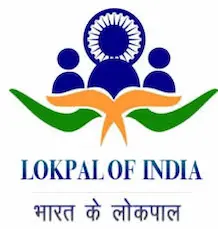
Why in News?
The Lokpal of India, the nation’s apex anti-corruption ombudsman, is moving forward with the recruitment of 81 approved posts on a deputation basis, as part of a structural overhaul to address longstanding staffing shortages and rising complaint volumes.
Background: Evolution of the Lokpal Institution
Initial Proposal – 1966
- Introduced by the First Administrative Reforms Commission (ARC)
- Aimed to address high-level corruption in public offices
- Recommended the creation of an independent authority to investigate public officials, including ministers and MPs.
Legislative Roadblocks (1971–2008)
- Multiple Lokpal Bills introduced but repeatedly failed to pass due to political disagreements and lack of consensus.
Jan Lokpal Movement – 2011
- Spearheaded by Anna Hazare, this was a mass civil society agitation demanding a strong, independent Lokpal.
- Catalyzed public and political pressure for institutional anti-corruption reform.
Enactment and Establishment – 2013–2014
- The Lokpal and Lokayuktas Act, 2013 was passed in December 2013.
- The Lokpal was officially notified on January 16, 2014, marking its legal establishment.
Recent Institutional Developments (2024–2025)
- In response to increased complaints and inefficient functioning, 81 deputation posts were approved to bolster the Lokpal’s investigative and administrative capacity.
Legal and Institutional Framework
Lokpal and Lokayuktas Act, 2013
- Provides for establishment of a Lokpal at the Centre and Lokayuktas in the states
- Applies to:
- Prime Minister (with certain exceptions)
- Union Ministers
- MPs
- Group A, B, C, and D officers
Powers of the Lokpal
- Investigates cases under the Prevention of Corruption Act, 1988
- Can confiscate property and recommend disciplinary action or prosecution
- Functions independently; cannot be directed by any other authority
Lokpal vs. Lokayukta – A Comparative Table
| Feature | Lokpal (Central) | Lokayukta (State) |
|---|---|---|
| Legal Basis | Lokpal and Lokayuktas Act, 2013 | State-specific laws (under Section 63 of the 2013 Act) |
| Jurisdiction | Central public servants, incl. PM (with exceptions) | State officials – CM, MLAs, state bureaucracy |
| Appointment | By President; on recommendation of a selection committee | By Governor; process varies per state |
| Composition | Chairperson + up to 8 members (legal/judicial/other experts) | Usually Chairperson + members with legal/judicial background |
| Tenure | 5 years or until 70 years of age | As defined by state laws |
| Removal Process | Supreme Court inquiry | Defined by state legislation |
| Salary | Chairperson = Salary of Supreme Court Judges | Modeled on Lokpal Act; varies by state |
| Powers | Under PC Act; confiscate assets; recommend prosecution | Investigate corruption; recommend actions to state government |
Significance and Challenges
Significance
- Strengthens public trust in institutions
- Ensures accountability of top public servants
- Reflects democratic responsiveness to civil society pressure
Challenges
- Delayed appointments and institutional inertia
- Limited enforcement powers in some contexts
- Coordination gaps with other anti-corruption agencies (CBI, CVC)
- Underperformance in some states where Lokayuktas are weak or non-existent
Exam Connect – Possible Questions
Prelims
- Which of the following is true about the Lokpal of India?
A. It can directly prosecute ministers and MPs in a court of law
B. It is established under a constitutional provision
C. It is a statutory body with powers under the Prevention of Corruption Act
D. It is an advisory body under the Prime Minister’s Office
Answer: C. It is a statutory body with powers under the Prevention of Corruption Act - Which event led to the passage of the Lokpal and Lokayuktas Act, 2013?
A. The Emergency of 1975
B. Anna Hazare-led Jan Lokpal Movement
C. RTI Campaign of 2005
D. Nirbhaya Case Protests
Answer: B. Anna Hazare-led Jan Lokpal Movement - The appointment of the Lokpal of India is made by:
A. Prime Minister
B. Parliament
C. President based on a Selection Committee’s recommendation
D. Chief Justice of India
Answer: C. President based on a Selection Committee’s recommendation
Mains
- “The Lokpal of India was envisioned as a cornerstone of anti-corruption reform. Critically evaluate its structure, powers, and performance since its inception.”
- “Compare and contrast the roles and jurisdiction of Lokpal and Lokayuktas. Suggest measures to strengthen their institutional effectiveness.”
- “Discuss the ethical importance of independent anti-corruption bodies like the Lokpal in strengthening democratic accountability.”
4. Kargil, Pahalgam and the Revamp of India’s Security Strategy – Defence & Security
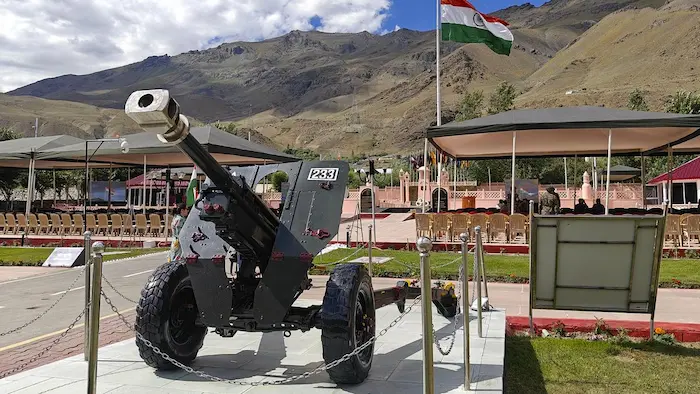
Why in News?
July 26, 2025, marks the 26th anniversary of the Kargil War, prompting a reflection on India’s evolving defence and counter-terrorism strategies. Recent operations like Operation Sindoor highlight significant military advances and doctrinal shifts.
Kargil War: Lessons Learned
- Date of Conflict: May–July 1999
- Background: Pakistani soldiers and militants infiltrated Indian territory in the Kargil sector of Ladakh, occupying strategic heights.
- Outcome: Indian Armed Forces launched Operation Vijay, successfully reclaiming lost territory.
- Casualties: ~527 Indian soldiers martyred.
Key Deficiencies Exposed During Kargil War
- Intelligence Failure
- No actionable early warnings from RAW or military intelligence
- Infiltration went undetected for weeks
- Surveillance Gaps
- Lack of real-time satellite and aerial surveillance
- Poor visibility of terrain allowed Pakistani troops to entrench positions
- Operational Unpreparedness
- Shortage of high-altitude gear, snow boots, and winter shelters
- Troops lacked night-vision equipment and precision-guided weapons
- Logistics and Infrastructure Shortfalls
- Inadequate air support and terrain-specific logistics
- Delayed response impacted morale and coordination
Post-Kargil Reforms and Institutional Overhauls
- Establishment of:
- Defence Intelligence Agency (DIA)
- National Technical Research Organisation (NTRO) – for satellite surveillance
- Induction of advanced weaponry:
- Rafale jets, BrahMos missiles, night-vision systems, drones, etc.
- Boost to indigenous defence manufacturing under Make in India and Atmanirbhar Bharat
- Emphasis on joint operations, cyber defence, and border infrastructure
Recent Developments: Operation Sindoor
- Launched in Pahalgam, Jammu & Kashmir, in response to a terror attack
- Featured precision air and artillery strikes on terror infrastructure in Pakistan
- Demonstrates India’s doctrinal shift from strategic restraint to pre-emptive, punitive action
Changing Counter-Terrorism Strategy
| Phase | Key Features |
|---|---|
| Strategic Restraint (1990s–2010s) | Cautious military response, diplomatic engagement |
| Proactive Deterrence (Post-Uri & Balakot) | Targeted cross-border strikes, drone operations, increased surveillance |
| Integrated Warfare (2020s onward) | Use of AI, cyberwarfare tools, and real-time intelligence sharing among tri-services units |
Persistent Security Challenges
- Cross-border terrorism (especially in Kashmir and Punjab regions)
- Cybersecurity threats and increasing digital infrastructure vulnerabilities
- Need for tri-service coordination and modernised procurement
- Geopolitical threats from Pakistan-China nexus and unstable Afghanistan region
Himachal Pradesh Context
- HP shares strategic proximity with the Union Territory of Ladakh and parts of Punjab
- Importance of Himachali regiments in high-altitude warfare (e.g., Dogra and JAK Rifles)
- Implications of security preparedness for mountain terrain and border areas
Exam Connect – Possible Questions
Prelims
- Which of the following organisations was created as a direct result of lessons learned from the Kargil War?
A. National Security Guard (NSG)
B. National Investigation Agency (NIA)
C. Defence Intelligence Agency (DIA)
D. Central Industrial Security Force (CISF)
Answer: C. Defence Intelligence Agency (DIA) - What was the primary objective of Operation Vijay in 1999?
A. Neutralize terror camps in Punjab
B. Flush out infiltrators in the Kargil sector
C. Carry out cross-border air strikes in Balakot
D. Secure the Siachen Glacier
Answer: B. Flush out infiltrators in the Kargil sector - Which of the following best describes Operation Sindoor?
A. A humanitarian operation in Ladakh
B. A surgical strike in Myanmar
C. A recent counter-terror operation in Pahalgam
D. A cyber security drill by the Indian Army
Answer: C. A recent counter-terror operation in Pahalgam
Mains
- “The Kargil conflict was not just a military event but a turning point in India’s defence and intelligence strategy.” Analyze in the context of post-Kargil reforms.
- “Despite considerable modernization, India’s security challenges are evolving. Discuss the need for integrated warfare capabilities in dealing with emerging threats such as cyber terrorism and drone warfare.”
- “India’s shift from strategic restraint to proactive counter-terrorism marks a new doctrine in national security. Critically evaluate this approach.”
5. India–UK Comprehensive Economic and Trade Agreement (CETA): A Strategic Bilateral Milestone – International Relations
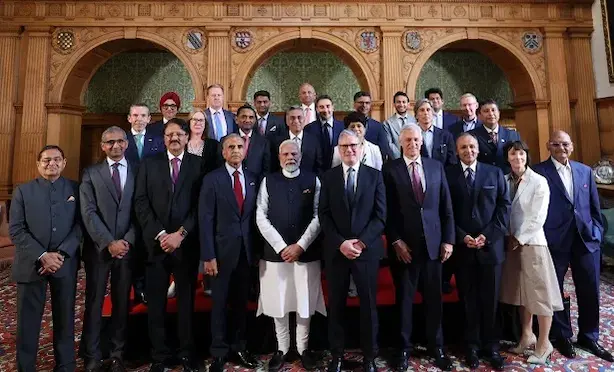
Why in News?
On a historic visit to the UK, Prime Ministers Keir Starmer and Narendra Modi signed the Comprehensive Economic and Trade Agreement (CETA) at Chequers, making it the largest UK trade deal post-Brexit and India’s first trade pact with a G7 economy in over a decade.
Key Highlights of the CETA
- First major trade pact for India with a Western power since FTAs with ASEAN and Japan.
- For the UK, CETA serves as a strategic realignment post-Brexit to reduce dependency on EU markets.
- Negotiations had begun in 2007, stalled over EU demands, and resumed after India’s exit from RCEP in 2019.
Alignment with the India–UK Roadmap 2030
CETA strengthens collaboration across:
- Trade and investment
- Science & technology
- Education and mobility
- Defence and climate partnerships
Economic and Trade Provisions
For India:
- Tariff reductions on 90% of British goods
- E.g., Scotch whisky, high-end automobiles
- Opportunity to attract UK investments in manufacturing and digital services
- Enhanced access to UK markets for Indian textiles, pharma, and IT services
For UK:
- Duty elimination on a wide range of Indian exports
- Access to India’s fast-growing consumer market
- Greater influence in the Indo-Pacific region via trade diplomacy
Projected Impacts
- Estimated $34 billion increase in bilateral trade over five years
- GDP impact (UK): Estimated rise of £4.8 billion by 2040
- Boosts job creation, technology exchange, and supply chain resilience
Key Challenges and Unresolved Issues
- Mobility for Indian professionals, especially IT and healthcare sectors
- Non-tariff barriers and UK regulatory restrictions in agriculture and food products
- Pending investment protection treaty negotiations
- Concerns over IPRs: Changes in India’s patent framework may affect public health safeguards
Geopolitical and Strategic Importance
- Counters China’s influence in global trade routes
- Reinforces India’s “Act West” policy
- Symbolic of economic alignment between democracies in a multipolar world
- Demonstrates India’s intent to diversify beyond RCEP, EU, and US trade dependencies
Himachal Pradesh Context
- Potential for export opportunities in HP’s sectors like:
- Organic horticulture and handicrafts
- Ayurvedic and pharmaceutical products
- Boost to education exchange and UK scholarships for Himachali students
- Encouragement for startups and service-based industries through UK collaborations
Exam Connect – Possible Questions
Prelims
- The India–UK CETA is significant because:
A. It is India’s first agreement with an EU country
B. It removes all visa restrictions for Indian professionals
C. It is India’s first trade deal with a G7 country in over a decade
D. It is a defence agreement with the UK
Answer: C. It is India’s first trade deal with a G7 country in over a decade - Which of the following sectors is expected to benefit most from the India–UK CETA?
A. Agriculture subsidies
B. Textiles and Pharmaceuticals
C. Coal and fossil fuels
D. Rail transport
Answer: B. Textiles and Pharmaceuticals - Which key issue remains unresolved under the India–UK CETA negotiations?
A. Climate change funding
B. Cross-border water sharing
C. Professional mobility and investment treaty
D. Renewable energy cooperation
Answer: C. Professional mobility and investment treaty
Mains
- “The India–UK Comprehensive Economic and Trade Agreement reflects a strategic economic realignment in a post-Brexit and post-RCEP world. Discuss its significance for India’s trade diplomacy.”
- “Bilateral trade agreements are increasingly replacing multilateral ones. Critically evaluate this trend with reference to the India–UK CETA.”
- “What are the expected economic gains and challenges for India under the CETA agreement with the UK? Suggest steps to maximize benefits while safeguarding national interests.”
6. 150 Years of Jim Corbett: Honouring a Pioneer of Indian Wildlife Conservation – History & Culture
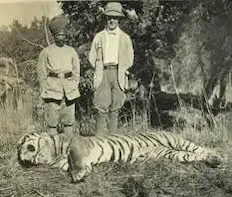
Why in News?
India is commemorating the 150th birth anniversary of Jim Corbett (1875–2025) — a legendary figure in India’s colonial and conservation history. Revered as a hunter-turned-naturalist, his name lives on through Jim Corbett National Park, India’s first national park and a major tiger conservation zone.
Who was Jim Corbett?
- Full Name: Edward James Corbett
- Born: July 25, 1875, in Nainital, British India
- Profession: Hunter, tracker, writer, and conservationist
- Known For: Tracking and killing man-eating tigers and leopards in the Kumaon region of present-day Uttarakhand
- Later Life: Became a strong advocate for wildlife conservation
Key Literary Contributions
Corbett’s books blend wildlife narratives with colonial-era life in India. They remain widely read and are considered foundational texts in wildlife literature.
Notable works include:
- Man-Eaters of Kumaon
- The Man-Eating Leopard of Rudraprayag
- Jungle Lore
- My India
These works not only document his hunts but also express his growing empathy for wildlife and critique of deforestation and habitat loss.
Legacy in Wildlife Conservation
Transition from Hunter to Conservationist:
- Originally known for eliminating man-eaters threatening villages, Corbett grew concerned over declining tiger populations.
- Became one of the earliest proponents of protecting India’s natural ecosystems.
Jim Corbett National Park:
- Established in 1936 as Hailey National Park, India’s first national park
- Renamed Jim Corbett National Park in 1957 to honour his contributions
- Located in Nainital district, Uttarakhand
- Now part of the Corbett Tiger Reserve under Project Tiger (launched in 1973)
Biodiversity and Geographical Importance
- Spread over ~520 sq. km in the sub-Himalayan belt
- Rich in flora and fauna:
- Home to 230+ tigers
- Hosts Asian elephants, leopards, crocodiles, gharial, and hundreds of bird species
- One of the most visited ecotourism destinations in India
- Plays a pivotal role in sustainable wildlife tourism and forest conservation awareness
Himachal Pradesh Context
- HP’s high-altitude national parks (e.g., Great Himalayan National Park) are also part of India’s conservation legacy.
- Jim Corbett’s early writings and conservation values influenced wildlife practices in the Himalayan region.
- His model of community-inclusive conservation is relevant to HP’s eco-sensitive tribal belts.
Exam Connect – Possible Questions
Prelims
- Jim Corbett National Park was initially established under which name in 1936?
A. Ramganga National Park
B. Kumaon Wildlife Reserve
C. Hailey National Park
D. Nainital Tiger Reserve
Answer: C. Hailey National Park - Which of the following books was written by Jim Corbett?
A. Jungle Book
B. The Man-Eating Leopard of Rudraprayag
C. Vanishing Stripes
D. India’s Wildlife: A Primer
Answer: B. The Man-Eating Leopard of Rudraprayag - Where is Jim Corbett National Park located?
A. Himachal Pradesh
B. Sikkim
C. Uttarakhand
D. Assam
Answer: C. Uttarakhand
Mains
- “Jim Corbett’s transformation from a colonial hunter to a conservationist highlights the early environmental consciousness in India. Discuss his legacy in shaping India’s conservation ethos.”
- “Discuss the role of protected areas like Jim Corbett National Park in promoting biodiversity conservation and sustainable tourism in India.”
- “Assess the influence of colonial-era naturalists like Jim Corbett on present-day conservation strategies in the Indian Himalayan region, including Himachal Pradesh.”
7. The Scientist Who Made ‘Mangroves’ a Buzzword: Legacy of M.S. Swaminathan in Environmental Conservation – Environment
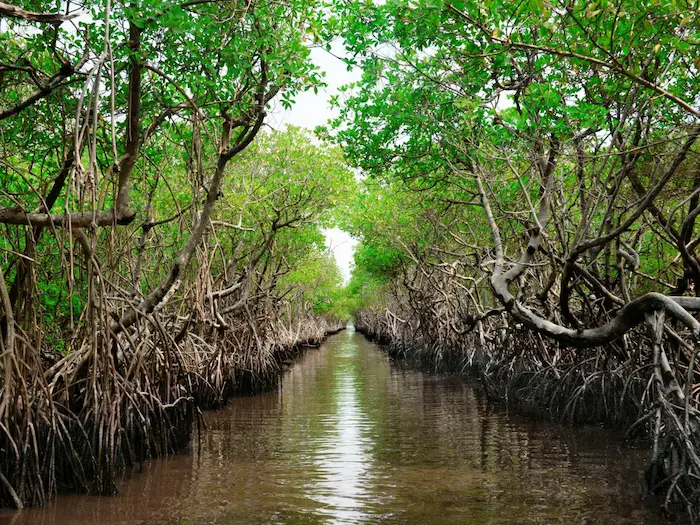
Why in News?
As the world celebrated World Mangrove Day (July 26), tributes were paid to M.S. Swaminathan, whose scientific advocacy helped bring mangrove ecosystems to global attention. Once valued primarily for fuel, fish, and fodder, mangroves are now hailed as vital ecological protectors — for climate adaptation, coastal resilience, and carbon storage.
Key Highlights
- Mangroves are now integral to climate change mitigation, disaster risk reduction, and biodiversity protection.
- The advocacy of M.S. Swaminathan was instrumental in shifting perceptions and policies around mangrove ecosystems.
- India has seen significant growth in mangrove restoration, thanks to scientific initiatives and community-based management models.
M.S. Swaminathan and Mangrove Conservation
- Globally acclaimed agricultural scientist, best known as the father of India’s Green Revolution.
- Also a pioneer in mangrove advocacy, promoting their role in:
- Cyclone buffering
- Carbon sequestration
- Fishery support systems
- Protection of vulnerable coastal communities
Key Contributions:
- Founded the International Society for Mangrove Ecosystems (ISME) – A global platform for mangrove research and policy advocacy.
- Promoted Joint Mangrove Management (JMM) – A community-participatory model for mangrove regeneration, particularly in Odisha, West Bengal, and Tamil Nadu.
- Highlighted the ecological and socio-economic value of mangroves in climate adaptation forums like UNFCCC and IPCC.
Mangrove Cover in India – 2025 Snapshot
- Total Mangrove Area: 4,991.68 sq. km
- Positive trend due to:
- Policy support under CAMPA and the Green India Mission
- Community involvement in restoration and protection
- Use of GIS mapping and satellite-based monitoring
- Key states:
- West Bengal (Sundarbans) – Largest cover
- Gujarat, Maharashtra, Andhra Pradesh, Tamil Nadu, Odisha – Other major contributors
Ecological Importance of Mangroves
- Act as carbon sinks, storing up to 4x more carbon than tropical forests
- Protect coastlines from cyclones, tsunamis, and storm surges
- Serve as nurseries for aquatic life (fish, shrimp, mollusks)
- Stabilize coastal soil and prevent erosion
- Support livelihoods through fishing, honey collection, and eco-tourism
Challenges to Mangrove Ecosystems
- Urbanisation and coastal development
- Aquaculture expansion (especially shrimp farming)
- Pollution and plastic waste
- Rising sea levels and salinity changes due to climate change
Himachal Pradesh Context
- While HP is not a mangrove region, community forest management models like Joint Forest Management (JFM) echo similar principles to Joint Mangrove Management.
- Conservation strategies in coastal areas provide valuable lessons for HP’s forest-based hill communities in managing sensitive ecosystems and climate adaptation.
Exam Connect – Possible Questions
Prelims
- Which of the following is not a benefit of mangrove ecosystems?
A. Carbon sequestration
B. Coastal erosion prevention
C. Freshwater generation
D. Nursery grounds for marine life
Answer: C. Freshwater generation - World Mangrove Day is observed every year on:
A. June 5
B. July 26
C. August 12
D. September 21
Answer: B. July 26 - Which organization was founded by M.S. Swaminathan to promote mangrove conservation?
A. Indian Society for Forest Research
B. International Society for Mangrove Ecosystems
C. Global Green Earth Alliance
D. Coastal Biodiversity Trust
Answer: B. International Society for Mangrove Ecosystems
Mains
- “Mangroves are nature’s first line of defence in coastal regions. Discuss their ecological and economic significance, highlighting India’s conservation efforts.”
- “Evaluate the role of scientific leadership and community participation in the conservation of vulnerable ecosystems, with reference to the contributions of M.S. Swaminathan.”
- “Discuss the ethical responsibility of scientists and policymakers in preserving ecological heritage. Illustrate with the example of mangrove conservation in India.”

